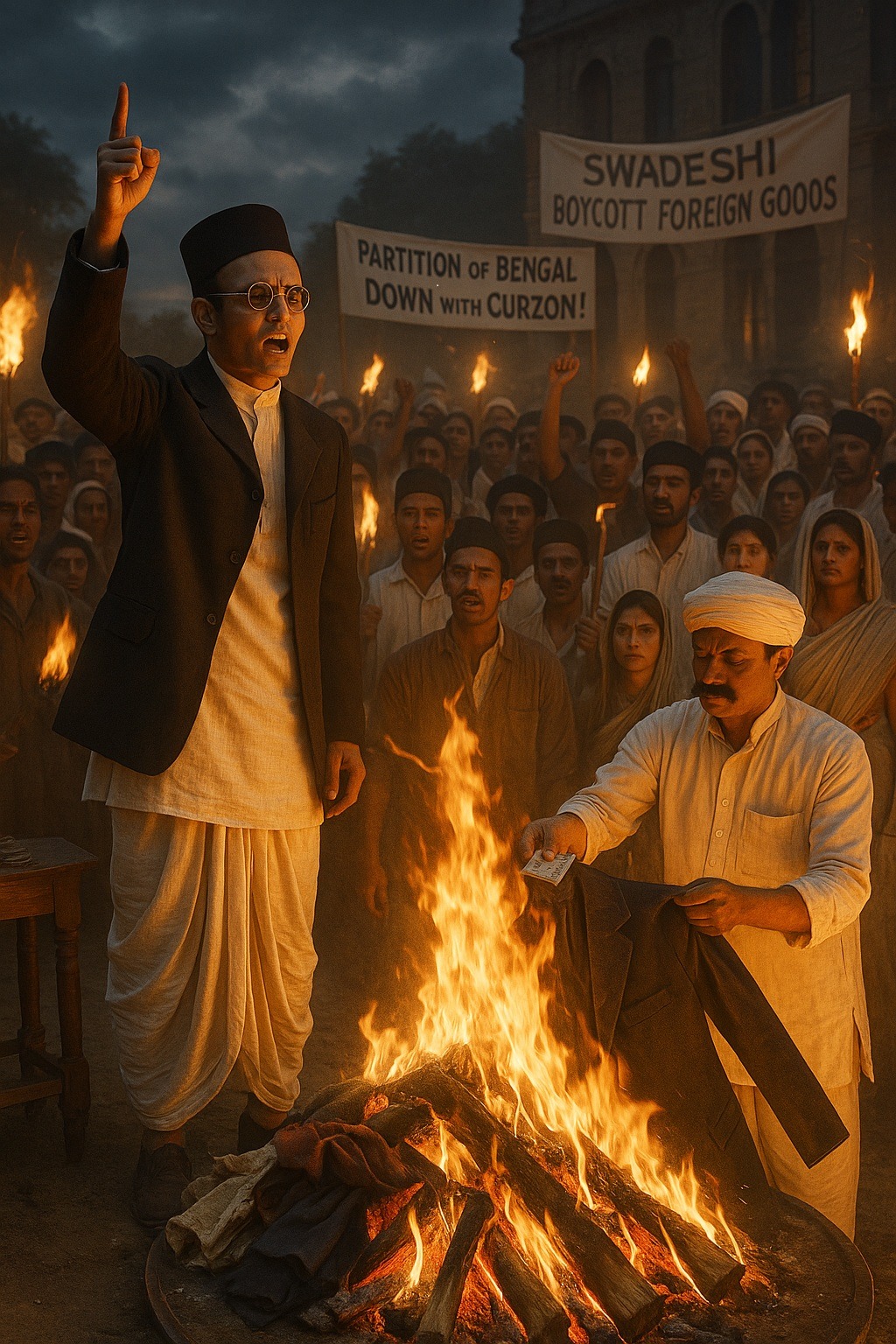In the history of India’s Swadeshi movement, it was Vinayak Damodar (Veer) Savarkar, not ‘Mahatma’ Gandhi, who first organized a public bonfire of foreign goods. A fact which gets often sidelined or ignored by ‘biased INC’ historians.
In 1905, when he was in his early twenties, Vinayak Damodar (Veer) Savarkar became a passionate student leader in Poona, inspiring young Indians to rise against British colonial rule. A strong supporter of the Swadeshi movement, Savarkar believed that refusing to use British-made goods was just as important as opposing the Partition of Bengal, which had been announced by Viceroy Lord Curzon and was to take effect on 6 October 1905.
On 1 October, speaking at a public meeting on behalf of the students, Savarkar gave an emotional speech urging Indians to burn foreign clothes and start using Indian-made products instead. His powerful words deeply moved the audience. When N.C. Kelkar suggested donating the clothes to the poor rather than burning them, Savarkar replied that a public act of renunciation—a visible rejection of British goods—would have a stronger moral and emotional impact.
With the help of his revolutionary group, Abhinav Bharat, Savarkar collected large amounts of British goods for the protest. Women’s groups also joined the movement, holding their own demonstrations and discarding foreign household items. On Dussehra, 7 October 1905, a grand procession of students and nationalists—including Bal Gangadhar Tilak, Paranjpe, and others—marched through Poona to Lakdi Pul, where a huge bonfire of foreign clothes was lit. Reports from the time say Savarkar’s speech moved the crowd deeply. In a symbolic act, Paranjpe checked the empty pockets of a foreign coat before throwing it into the fire—showing how British rule had drained India’s wealth.
The Principal of Fergusson College fined Savarkar ₹10 and expelled him from the hostel, making him the first Indian student to be punished by a British-supported institution for political activism—and the first to organize a public bonfire of foreign cloth. Unshaken, Savarkar paid the fine himself and donated the extra money raised by supporters to the nationalist movement.
This bold act spread revolutionary feelings far beyond Maharashtra and Bengal. It became a symbol of courage, sacrifice, and national awakening, foreshadowing the spirit that would later shape the Indian freedom struggle and define Savarkar’s lifelong mission.
Mahatma Gandhi too organized and encouraged bonfires of foreign goods, though many years later—during the Non-Cooperation Movement (1920–22) and the Civil Disobedience Movement (1930–34).
💭 What do you think? Did you know that Savarkar organized India’s first public bonfire of foreign goods—years before Gandhi did? Why do you think this important moment in India’s nationalist history is rarely mentioned in mainstream narratives? How significant is symbolic protest—like burning foreign clothes—in building a sense of national unity and resistance? Do you agree with Savarkar that a public act of renunciation has a stronger moral impact than private charity? Why or why not? Can we see parallels between the Swadeshi movement’s call for economic self-reliance and India’s present-day “Make in India” initiatives? 👉 Share your thoughts in the comments below!
Sources:
GODBOLE, Vasudev Shankar. 2004. Rationalism of Veer Savarkar. Itihas Patrika Prashan: Thane/Mumbai.
KEER, Dhananjay. 1988. Veer Savarkar. Third Edition. (Second Edition: 1966).Popular Prakashan: Bombay (Mumbai).
SAMPATH, Vikram. 2019. Savarkar (Part 1). Echoes from a forgotten past. 1883-1924. Penguin Random House India: Gurgaon.
WOLF, Siegfried O. 2009. Vinayak Damodar Savarkar und sein Hindutva-Konzept. Die Konstruktion einer kollektiven Identität in Indien [“Vinayak Damodar Savarkar and his concept of Hindutva: The construction of a collective identity in India.”]. Online Dissertation: Heidelberg University: Heidelberg.


Leave a Reply